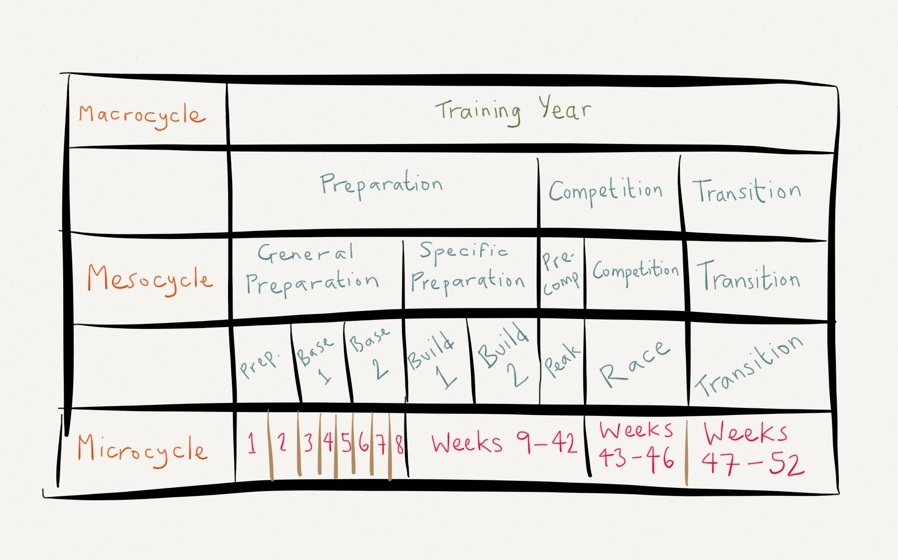Periodization simply means that you divide the year into different phases. These phases are then planned in a way that you reach your peak performance at a specific time – such as the start of a season, a competition or a physical test.
In the majority of cases we talk about five levels of planning, although there can be a sixth one (the Olympic cycle). The levels are:
The Yearly Cycle
All levels of planning put together determines your yearly cycle.
The Macrocycle
This is the plan (training cycle) leading up to a competition or test. A macrocycle normally spans over 8 to 20 weeks with 12 weeks being the most common duration.
The yearly cycle usually consists of 2 or 3 macrocycles. For some elite athletes, a yearly cycle can consist of as much as 4 to 5 macrocycles.
The Mesocycle
A macrocycle is divided into several phases called mesocycles. A mesocycle can also be called a “training block”, as it is a block of training that is oriented toward developing and/or maximizing certain physical capacities while other are kept at a maintenance level.
Usually the mesocycle last between 2 to 6 weeks with 3 to 4 weeks being the most common duration. Since advanced athletes tend to adapt more quickly to a specific stimulus, a mesocycle is usually shorter (2-3 weeks) for elite athletes and longer for intermediate athletes and beginners (4-6 weeks).
The Microcycle
A mesocycle consists of several microcycles. Each of these microcycles are normally referred to as a training week, as most coaches use programming that fits into a week (7 days). A microcycle can also last anywhere from 5 to 10 days.
So, if a mesocycle is 4 weeks long, it usually consists of 4 microcycles where each microcycle is one week in duration.
The Training Session
Your training session is the smallest unit you plan. As each microcycle is broken down to each individual day, your training session (or sessions) for each day is the final piece you plan. Each training session is structured to move you towards the goal of the training phase. The goal, or the content of your training, is usually decided at the mesocycle.
So why do we divide our training into so many different phases? No matter if you’re a bodybuilder, a football player or a runner, you can’t cover everything you need in every single training session.
If you’re a bodybuilder you need to gain muscle mass in the off season and you need to lose body fat before a contest. However, during the off season you might need to prioritize one or several body parts, you might need to get rid of injuries or correct muscle imbalances (who left unattended would lead to injuries). And if we look closer at the goal of building muscle mass we have to consider increasing our strength, improving our central nervous system, different ways to increase the training volume or other ways to force our bodies to adapt and become bigger – and of course, we need to plan for adequate recovery.
In other sports, you might need to increase both strength and power, get better conditioning and improve several sport specific skills.
So, when you start planning, you usually go from the most general goals to the most specific ones. For example, you need to build muscle and a good foundation before you start to prioritize your weak areas. This is also true for most other sports. Let’s look at an example for a power athlete:
We start with the macrocycle who normally has three mesocycles, these are:
Mesocycle 1: general physical preparation. You focus on the most general qualities. Usually this is referred to as building a good foundation. Focus is usually on increasing strength, building muscle mass, correct muscle imbalances, improving mobility and developing an endurance base.
Mesocycle 2: specific physical preparation. You focus on the most important physical qualities for your performance while the other are put on maintenance. Focus is usually on maximizing strength and/or muscle mass, improving power and, if needed, developing anaerobic capacity. Mobility is maintained. If needed, running is introduced.
Mesocycle 3: competitive preparation. You put it all together. This is where you transform the gains you’ve made and turn them into sport specific athletic performance. More time is spent on being a better athlete while less time is spent on developing physical qualities. Focus is usually on maximizing power, running speed and agility. If needed, continue to develop anaerobic power (short burst to simulate the action in for example ice hockey or American Football). Strength, muscle size and mobility is maintained.
